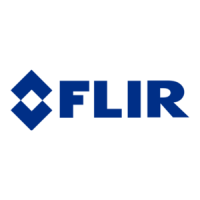Working with images
14
14.1 Saving an image
14.1.1 General
You can save images to a memory card.
The camera saves an image file including all thermal and visual information. This means
that you can open an image file at a later stage and, for example, select another image
mode, apply color alarms, and add measurement tools.
The image jpg file is fully radiometric and saved lossless, which enables full post-process-
ing in FLIR Tools. There is also a regular jpg part (lossy) for convenient viewing in non-
FLIR Systems software (Explorer).
14.1.2 About UltraMax
UltraMax is an image enhancement feature that increases the image resolution and lowers
the noise, making small objects easier to see and measure. An UltraMax image is twice as
wide and high as an ordinary image.
When an UltraMax image is captured by the camera, several ordinary images are saved in
the same file. Capturing all the images can take up to 1 second. To fully utilize UltraMax,
the images need to be slightly different, which can be accomplished by a slight movement
of the camera. You should hold the camera firmly in your hands (do not put it on a tripod),
which will make these images vary just a little during the capture. Correct focus, a high-
contrast scene, and a non-moving target are other conditions that help to achieve a good-
quality UltraMax image.
At the moment, only FLIR Tools has the ability to process UltraMax images. Other FLIR
software will treat the image as a regular image.
14.1.3 Image capacity
The capacity of a 4 GB memory card is theoretically 13 000 images (with no annotations).
Note Although a memory card may have a higher capacity than 5000 images, saving
more than that number of images severely slows down file management on the memory
card.
14.1.4 Naming convention
The naming convention for image files is FLIRxxxx.jpg, where xxxx is a unique counter.
14.1.5 Procedure
Follow this procedure:
1. To save an image, push the Autofocus/Save button fully down.
#T559879; r. AO/35410/35410; en-US
34

